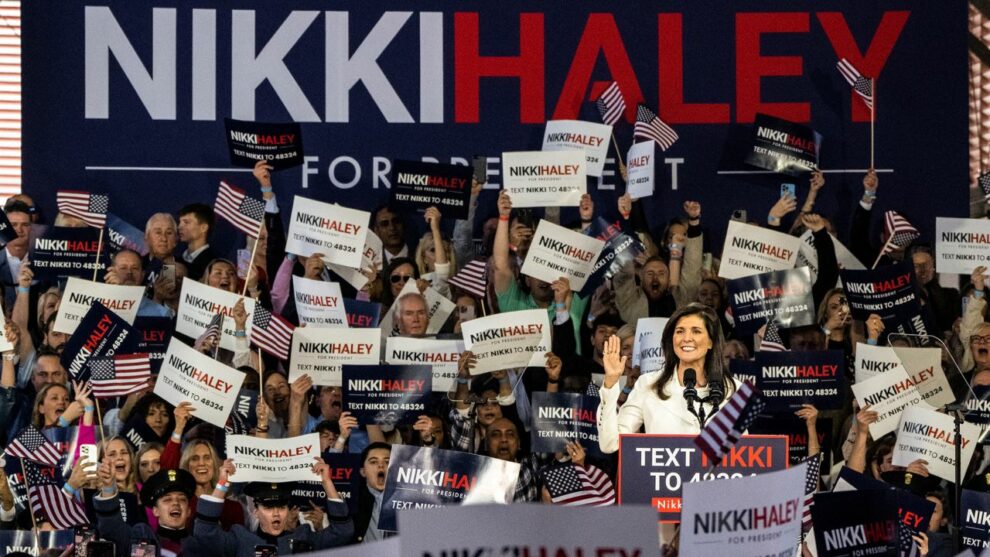The nascent 2024 presidential campaign seemed to hit a different gear this week with Nikki Haley entering the Republican primary. The former South Carolina governor and onetime United Nations ambassador joins former President Donald Trump as the only major competitors to declare bids for the presidency.
Haley’s announcement, and the lack of one so far from President Joe Biden and a slew of Republicans, including Florida Gov. Ron DeSantis, got me thinking: Do primary winners tend to be early or late entrants to the presidential race?
The answer depends on who else is running. If you’re in a primary without an incumbent, then it’s better to be early, while it matters far less with an incumbent running.
The right time to run
The modern primary era began in 1972 on the Democratic side and in 1976 on the Republican side. Since then, hundreds of major candidates have decided to run for president or at least formed exploratory committees with the Federal Election Commission. For each of them, I jotted down whichever date was first, to see if there was a pattern.
It turns out that the median date for candidates to enter a presidential primary without an incumbent has been March 16 the year before the general election. There has been a wide variation on that from year to year. Some years, the median candidate gets in really early (January 2007 for the 2008 cycle on both the Democratic and Republican side), while other years it’s much later (August 1991 for the 1992 cycle on the Democratic side).
There is no real correlation between how late or how early a field forms and the eventual nominee’s success in the general election. Democrats, for example, won the presidency in both 1992 and 2008, even with a much later start in 1992.
What does seem to matter for winning a primary is when candidates get into the race compared with their competitors. In the 17 primaries since 1972 that did not feature an incumbent, 10 of the winning candidates entered earlier than that year’s median candidate. Two of the winners were the median candidates. Five got into the race later than the median candidate.
There were six who started running about one and a half months or more before that cycle’s median candidate. Democrat George McGovern, in the 1972 cycle, started nearly a full year before the median hopeful that cycle.
McGovern remains the only major-party nominee who had less than 5% of the vote in early national surveys while the polling leader had more than 20% support. McGovern’s success is part of the reason why primary campaigns seem to start so early compared with when the actual voting takes place.
Getting in the public eye early, raising money and building an organization are key to winning a presidential campaign. If you fall too far behind, it can be a disaster.
Even candidates you might “think” entered the race late, often got in far earlier. Trump’s June 2015 official announcement became well known for his ride down the escalator. Less remembered was the fact that he started an exploratory committee in March 2015, and he was already campaigning at the time.
Of course, joining a presidential race early is no guarantee of success. Former Florida Gov. Reubin Askew in the 1984 cycle and ex-Maryland Rep. John Delaney in the 2020 cycle filed with the FEC for the Democratic primary less than a year after the previous presidential election. Neither got very far.
Still, on the whole, joining early is better than getting in late. After all, the winners who have gotten in late didn’t get that late. The latest, for example, was Republican Ronald Reagan in the 1980 campaign. He entered less than three months after the median candidate.
Biden, in the 2020 cycle, was the other winning candidate to enter more than 15 days after the median candidate.
Both Biden and Reagan shared some qualities that few others had. They had previously run for president and were well known nationally, so they didn’t need time to build name recognition or a campaign and fundraising apparatus.
What we’ve seen more often is the late-entering “savior” candidate who enters on a white horse – and fails. Think about former Tennessee Sen. Fred Thompson in the 2008 cycle and then-Texas Gov. Rick Perry in the 2012 cycle. Both Republicans entered with a splash and proceeded to win zero primaries combined. The same was true for Democrat Mike Bloomberg in the 2020 cycle, though he won American Samoa.
Advantage incumbents
For incumbents, meanwhile, there’s a much greater ability to wait before indicating publicly that they’re going for another term.
The median date, since 1976, for presidents to either form an exploratory committee or announce their campaign is April 30 of the year before the general election. That’s about a month and a half later than when the median nonincumbent’s campaign gets started.
Some presidents do go early. Trump’s failed 2020 reelection campaign started the moment he entered the White House. (He formed an exploratory committee on Inauguration Day.)
Later is the general rule, however, for incumbents. Reagan’s highly successful 1984 reelection campaign, for instance, didn’t get underway until October 1983. George H.W. Bush, likewise, got going on his 1992 reelection bid in October 1991.
It shouldn’t be too surprising that incumbents can afford to go later. They rarely have any major competitors for their party nomination. They have universal name recognition, and incumbents don’t need the same amount of time to ramp up their campaign infrastructure to raise money.
All of that seems to match up with what Biden is going through at this point. In fact, some reports suggest he’ll likely announce a reelection bid in April.
But for Republicans wondering whether it’s too soon to start campaigning, history is pretty clear. It’s better to start sooner or you might fall too far behind to recover.
source: CNN
















